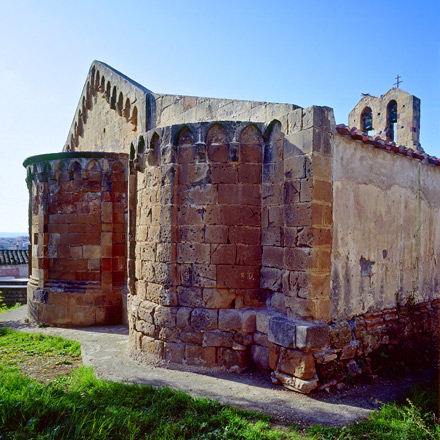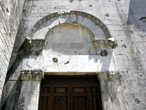The Church
The Abbey of San Pietro, simply ‘the abbey’ for the inhabitants of Camaiore, is what is left from a Benedictine abbey reported ever since the upper Middle Ages and competing with the nearby Pieve di Camaiore for the primacy of the oldest ecclesiastical institution of the area. Enclosed in the 13th century by a wide circle of embattled walls – whose evidence is but a single door opening in front of its façade – the monastic complex was a very important resting place for pilgrims, who could find assistance along the track of the Via Francigena. Indeed, the site was mentioned as an intermediate stopover between Lucca and Luni by Sigeric, archbishop of Canterbury, who stopped there between 990 and 994 on his way back from Rome to his home land.
The present church was built in the 12th century, yet it was reworked in several steps. The sections referring to the original construction – façade and apse – represent a clear, coherent example of Romanesque of Lucca, marked by a great architectural harmony, underlined by a regular masonry framework and by the lack of decorations.
Description »
The edifice has got a basilical plan without a transept, with three naves marked by piers and a semicircular apse. Behind the second pier on the left, an altar was built to enframe a fresco also covering the pier itself.
A single portal with raised archivolt and a mullioned window mark the plain, gabled front.
As the rest of the church, the façade is built in a local stone of greyish hues, laid in squared ashlars placed in regular courses. The top of the tympanum, the mullioned window and the façade portal are built in white limestone, yet scholars do not agree upon the chronology of these details, which might not be exactly coeval to the original construction. The apse and the back section show a similar masonry, though here it is marked by pilasters. The sides have been involved in more complex works throughout the history of the building.
The campanile is separated from the church and is adjacent to the apsidal area.
History »
A church dedicated to S.Pietro was confirmed in the area since 760, subordinate to the pieve of Camaiore in 984; yet, it is in the following centuries that the abbey started covering an increasingly important role, which would lead it to obtain Pope Alexander III’s protection in 1180. He set the church free from the episcopal authority, making it directly subordinate to the Holy See. This is the height of the abbey development, when the present construction was built, including its annexes, now partly got lost. In the subsequent century, the abbey would be surrounded by crenelated walls; nevertheless, as early as in the 15th century, Benedictine monks left the abbey, later occasionally occupied by friars from other orders. In 1532, the church and the monastery, by then in a state of ruin, were assigned to the Spedale di S. Luca in Lucca.
Works »
On the first two piers on the left hand inside the church, a Saint Mary of Egypt and a frescoed Piety are the residues of a once broader decoration. The Piety, making the object of a special devotion, was enframed by a sumptuous Baroque altar.
Restorations »
In the years 1856-1859, the church underwent significant restoration works under the direction of the architect Giuseppe Pardini. On that occasion, wide portions of the wall face were replaced and the large windows opened in the aisles in the 17th-century were replaced by single-light windows. At the end of the 19th century, the decision to create a cemetery along the southern side of the building implied the demolition of structures set against it, as well as the opening of a door on the southern side. After a few years, in 1902, the campanile was totally rebuilt.
Bibliography »
M.P. Gavioli Andres, L. Luisi Galleni, Pievi romaniche della Versilia: itinerari storico-artistici, Lucca 1999, pp. 59-69.
M.T. Filieri, S. Russo (a cura di), La piana lucchese e la Versilia, Milano 2000, pp. 154-155.
C. Taddei, Lucca tra XI e XII secolo: territorio, architetture, città, Parma 2005, 367- 379.
Location
























 Abbey
Abbey
 Two-light mullioned window
Two-light mullioned window
 Nave/Aisles
Nave/Aisles
 Gable
Gable Apse
Apse
 Fresco
Fresco
 Archivolt
Archivolt
 Single-light window
Single-light window
 Portal
Portal





